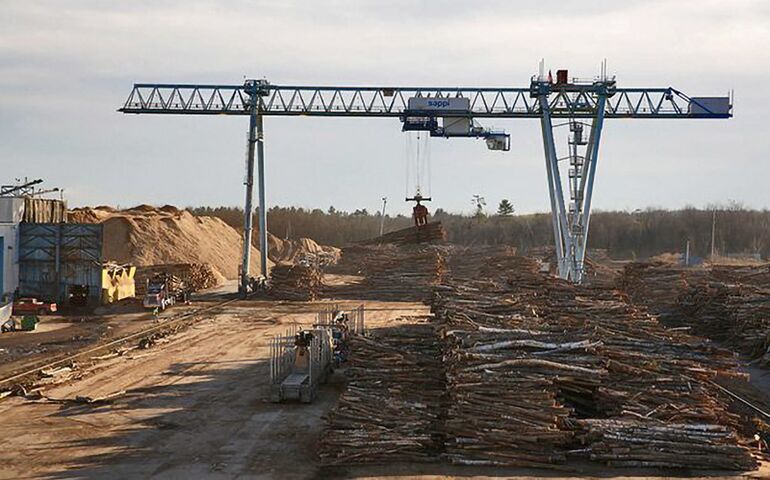First chapter in comeback story for rural Maine?
 Courtesy / Sappi North America
The woodyard at Sappi North America's Somerset Mill in Skowhegan. Maine's forest products industry is getting a $1 million boost from the federal government to implement a strategic plan for capitalizing on promising new markets for wood products, including wood fibers not used in the papermaking process that can be converted into biomaterials for manufacturing a host of products.
Courtesy / Sappi North America
The woodyard at Sappi North America's Somerset Mill in Skowhegan. Maine's forest products industry is getting a $1 million boost from the federal government to implement a strategic plan for capitalizing on promising new markets for wood products, including wood fibers not used in the papermaking process that can be converted into biomaterials for manufacturing a host of products.
Maine’s struggling forest products industry, which has been hit hard by the closure of six pulp and paper mills in the past three years, is getting a $1 million boost from the federal government to implement a strategic plan for capitalizing on promising new markets for wood products.
Matt Erskine, deputy assistant secretary of commerce for economic development of the federal Economic Development Administration, told a gathering Wednesday of forest industry stakeholders in Passadumkeag that additional federal grants of $200,000 to the Eastern Maine Development Corp. for the redevelopment of the former Verso Paper mill site in Bucksport and $145,000 to the Maine International Trade Center to assist small businesses exporters had been awarded to support the next steps in renewing Maine’s $8.5 billion forest economy and its 33,538 total jobs.
Included in those next steps is a commitment for the Oak Ridge National Laboratory, a world leader in composite materials manufacturing, to collaborate with the University of Maine on the development of biobased materials.
The Oak Ridge lab and the U.S. Department of Energy also will provide technical expertise to Maine’s biomass sector around new opportunities in combined heat and power.
Other next steps address mill site redevelopment, broadband access for communities affected by mill closures, support for small businesses and training programs for high school students interested working in the logging industry.
Erskine also delivered a 134-page report developed by the federal Economic Development Assessment Team after its three-day visit to Maine last summer that spells out eight recommendations for strengthening Maine’s forest economy, which has experienced a $1.3 billion decline in total economic impact since 2014.
“The federal team saw firsthand how the state has been impacted by the recent industry challenges and also witnessed how the industry and many communities have come together to identify priorities for economic development,” Erskine said during a press conference at the American Forest Management wood yard in Passadumkeag. “The EDAT and its federal partner agencies are supporting those new ideas by identifying potential resources and programs and providing some funding so these strategies can begin to be implemented. We will continue to work with local stakeholders on these strategies in the upcoming months and years.”
Overriding goal: 'Sustain good-paying jobs' in rural Maine
Patrick Strauch, executive director of the Maine Forest Products Council and co-chairman of the Maine Forest Economy Growth Initiative, said the EDA funding will help support the nine-point strategic plan the stakeholders group unveiled last week.
“Having the federal resources available to support the strategic plan is welcomed and appreciated,” Strauch said. “Members of the Maine Forest Economy Growth Initiative identified this roadmap as the crucial first step in positioning Maine as a global leader in the forest products industry. The strategic plan will identify the most promising new markets for wood products and analyze Maine’s wood supply to understand how to meet those new demands. Ultimately, the strategic plan will be used to attract investors, develop greater prosperity in the forest products sector, and sustain good-paying jobs in Maine’s rural communities.”
Dana Doran, executive director of the Professional Logging Contractors of Maine, welcomed the federal support and the focus on finding new opportunities for wood products. A study released last fall showed Maine's logging industry contributed an estimated $882 million to the state's economy in 2014, supported more than 7,300 jobs, including more than 4,600 direct logging jobs and additional jobs in industries such as trucking.
“Loggers and truckers are the root of the forest products value chain in Maine and right now that root is compromised,” Doran said in a written statement sent to Mainebiz. “This has the potential to threaten the entire forest products value chain and the many rural communities that depend on it. Our strongly held tradition of a market for every tree has been compromised and we need to create a plan for how to stem the losses, protect what we have and create opportunities for growth.”
Doran said the process launched last summer with the three-day visit of the EDAT team has jumpstarted the development of a long-term strategic plan to revive the state’s struggling forest economy.
“We hope we are writing the first chapter in the comeback story for rural Maine,” he said in his statement.














Comments